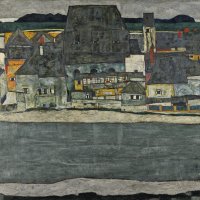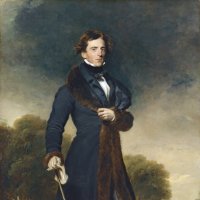New York City, 3 (unfinished)
In view of the Nazi advance, in 1938, after the signing of the Treaty of Munich, Piet Mondrian decided to abandon Paris, his city of residence for nearly twenty years, and moved to London, where his friends Ben and Winifred Nicholson found him a studio in Hampstead. Two years later, following the air raids on London and the German occupation of Paris, he decided to accept the invitation of the young American painter Harry Holtzman and settled in New York, where he spent the last years of his life. The exodus of European artists to America was a widespread phenomenon during those years and for all of them the new physical and intellectual environment brought about changes in their art.
As a result of the impact of Manhattan and American culture, coupled with the interest Mondrian had developed in jazz music years earlier, his painting lost its previous rigidity and acquired greater freedom and a more lively rhythm. From the outset he was powerfully attracted by the dynamism of the great metropolis, its quadrangular layout and its towering buildings which, as he used to say, were “the furthest from nature, ” but also by the latest developments in rhythm and counter-rhythm in jazz and by the new boogie-woogie style that had fascinated him earlier in Paris.
In 1983 the New York Museum of Modern Art staged an exhibition of the “Studio-wall compositions, ” the paintings found in his last studio on 59th Street at his death. Among them was the New York City, 3 in the Museo Thyssen-Bornemisza, which was previously called New York City, New York or New York City IV until Joop Joosten established the current title as original and definitive in the catalogue raisonné of the work of Mondrian. As a rule, Mondrian kept works in his studio for long periods and made successive alterations until achieving the desired balance between line and colour. Joosten mentions a first state of the present canvas, entitled Composition with Yellow and Blue, possibly begun in 1938. According to this information, the present painting should be included among the seventeen works, some unfinished and others complete, which the artist took with him from London to New York and which have been called the “Transatlantic paintings.”
The works Mondrian produced in America have been studied not only as a consequence of the effect the city had on the artist, but also from the point of view of the new technique they introduce. The thick black lines delimiting the fields of colour in his earlier works were replaced by a new material that broke away from the principle of flatness and facilitated his work: coloured adhesive tape. The fact that the strips of tape could be moved allowed him to modify their arrangement on the white canvas until achieving the most satisfactory and balanced layout for the composition. His initial endeavour to discover the harmony between surface, form and colour was now coupled with a new, more dynamic language. The final stage involved replacing the tapes with coloured painted strips, but this operation was only performed in one of the works in the series, New York City. The rest were left unfinished and should therefore be regarded as works in progress, in a state that Christopher Green aptly described as “suspended irresolution.”
According to the testimony of Professor Martin S. James, owing to its delicate state the painting was restored in 1977 by Bill Steeves and Harry Holtzman, Mondrian’s painter friend who managed his Estate. They reattached the tapes that had come loose and replaced those that were torn, taking care not to alter the colour or original arrangement.
Paloma Alarcó
Emotions through art
This artwork is part of a study we conducted to analyze people's emotional responses when observing 125 pieces from the museum.













